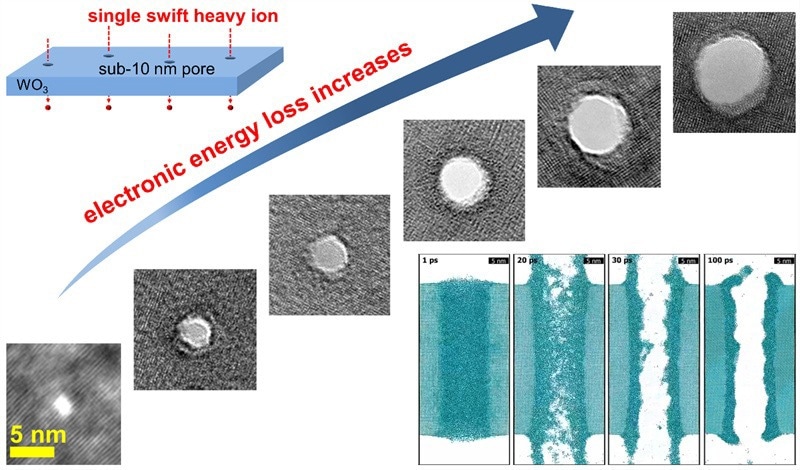Chinese scientists have proposed a new method for direct fabrication of sub-10 nm nanopores in WO3 nanosheets using swift heavy ions lately. The results have been published in Nano Letters.
 The sub-10 nm nanopores in the WO3 nanosheets created using single swift heavy ions. Image Credit: XU Lijun and ZHAI Pengfei
The sub-10 nm nanopores in the WO3 nanosheets created using single swift heavy ions. Image Credit: XU Lijun and ZHAI Pengfei
The study was conducted by the scientists at the Materials Research Center of the Institute of Modern Physics (IMP) of the Chinese Academy of Sciences (CAS) and their collaborator at the Joint Institute for Nuclear Research, Russia.
Fabrication of high-quality solid-state nanopores is of great importance to the applications of single molecule detection, nanofluidic devices and nanofiltration membranes. The most popular way to fabricate nanopores in inorganic films, such as SiN, SiO2 and Al2O3, is to use focused ion or electron beam.
However, the feedback system or direct imaging is required using this poring method, and only one single nanopore can be fabricated at a time, which limits mass production. Therefore, it is necessary to explore a new poring method which could create size- and density-controllable nanopores without any feedback system.
Based on the Heavy Ion Research Facility in Lanzhou (HIRFL), the scientists have demonstrated a direct poring method in WO3 nanosheets using swift heavy ions irradiation.
In addition, they applied molecular dynamics simulations to explain the underlying mechanism. It was found that the viscosity and surface tension of the transient molten phase caused by swift heavy ions are the key factors for the formation of nanopores.
By selecting ions of different electronic energy losses, the scientists created nanopores with sizes from 1.8 to 7.4 nm in WO3 nanosheets. They can control the density of nanopores by applying different ion fluences.
This new poring method, involving no chemical etching process, has certain potential for wide application. It paves the way to fabricate solid-state nanopores in materials with a low viscosity and surface tension using swift heavy ions, provides new insight into the latent ion track formation in solid materials.